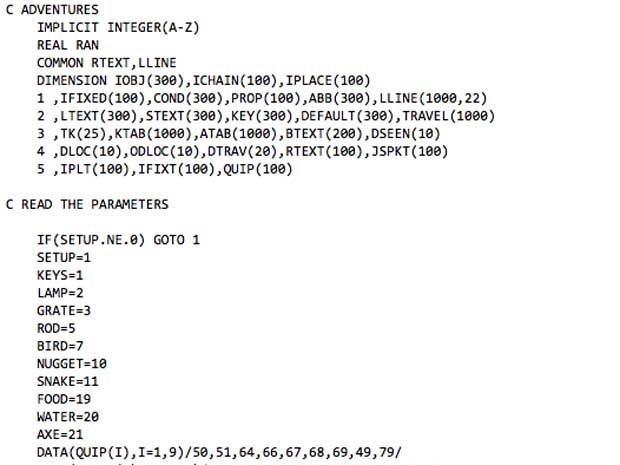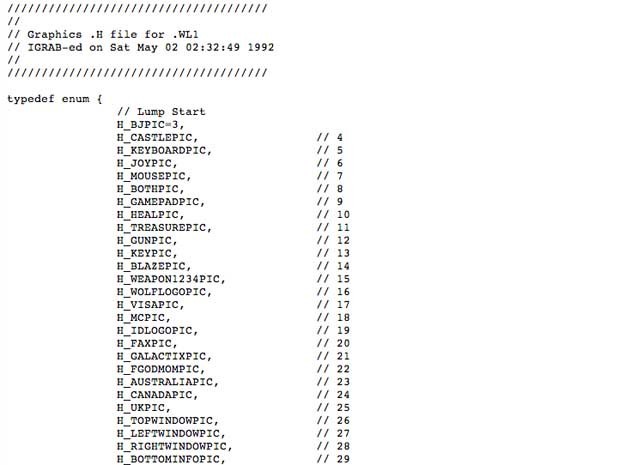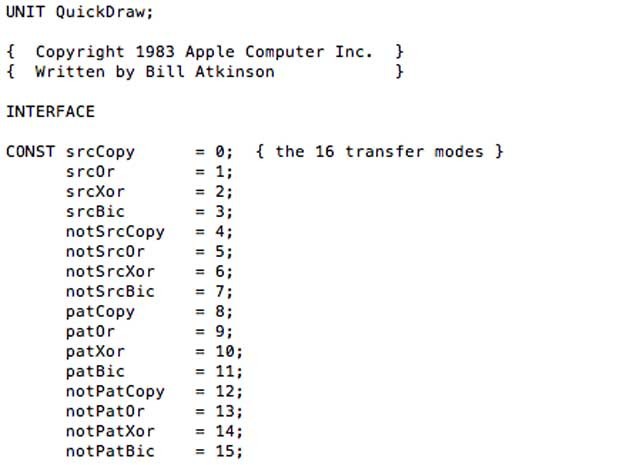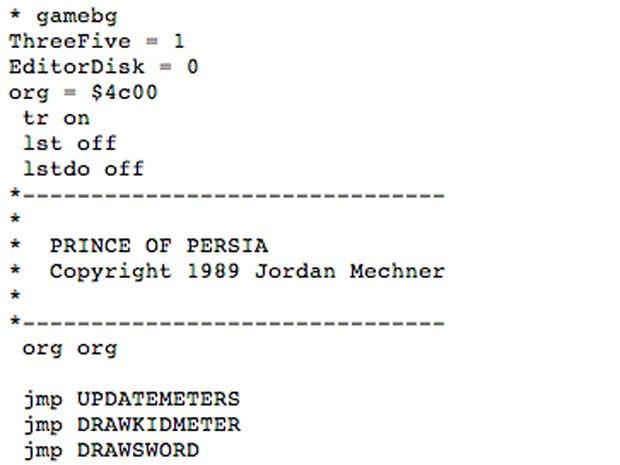Examples of classic code that has become open source

Last year, NASA published a list of software whose code they had been developing for many years. NASA has long been famous for sharing its code with the public. Other developers are not always ready to go for it. At least not right away. Let's take a look at some examples of classic code that can now be seen and touched.
Apollo spacecraft control computer (AGC)
')
The Apollo mission to the moon is considered to be a colossal achievement of mankind. For its implementation was done no less enormous work. This also applies to software developed by the MIT Instrumentation Lab. AGC was installed on both onboard and lunar modules to provide guidance, navigation and control. In honor of the 40th anniversary of the Apollo 11 mission in 2009, the original AGC code was decrypted and scanned from old records and made available to the public.

Those who wish to familiarize themselves with the AGC code or even to dig into it can download it (you can also download the virtual AGC simulator) from Google Code: code.google.com/p/virtualagc
IBMs APLð
APL is a programming language that became the heir to a system of mathematical notations for manipulating arrays. It was developed by Harvard University Professor Kenneth Iverson, who later influenced the development of such programming languages as J, Matlab and Mathematica. In 1962, working for IBM, Mr. Iverson formulated and published his work in a book called A Programming Language (APL). The first APL implementation was APLð for IBM System / 360 computers in 1966. And in 2012, IBM, together with the Computer History Museum, released the source code APLð, containing 37,500 lines and consisting of 360 assembly languages.

The source code for APLð is available for download on the Museum of Computer History website: www.computerhistory.org/atchm/apl360-software-license-agreement
Xerox Alto OS
Alto is a personal computer developed at Palo Alto Research Center (PARC) by Xerox Corporation in 1973. He became a revolutionary invention because he had a graphic display (black and white monitor 606x808), as well as a keyboard and mouse. Even more outstanding difference was the memory of 128 KB and the disk space of 2.5 MB, which was considered quite a lot at that time. There was a desktop concept and a graphical user interface. However, Alto was never sold, all 1,500 copies were used exclusively within Xerox.

On the website of the Computer History Museum you can download not only the OS, but also a lot of software and utilities developed for Alto: PUP (PARC Universal Packet) a set of inter-network protocols, Bravo is the first WYSIWYG editor and 4 programming languages (BCPL, Mesa, Smalltalk and Lisp): xeroxalto.computerhistory.org/xerox_alto_file_system_archive.html
CP / M OS
In 1979, Gary Kildall, a consultant for Intel, began developing software for managing a floppy disk drive (then still new). Soon this development turned into a new OS for computers based on Intel 8080 microprocessor, which he called CP / M (Control Program / Monitor, and later Control Program for Microcomputers). Unlike other operating systems of the time, CP / M was written not in the standard programming language, but in the one created by Kildall himself. CP / M also became the progenitor for quite common things in our time, such as 8-letter names and 3-letter file extensions. Kildall founded Digital Research, Inc. and patented its operating system, which became dominant among personal computers until DOS appeared in the 80s.

The source code for the first 4 versions of CP / M can be downloaded from the Museum of Computer History website: www.computerhistory.org/atchm/early-digital-research-cpm-source-code
Microsoft BASIC for 6502
In 1975, MOS Technology created a 6502 microprocessor, wanting to make it a cheap alternative to other microprocessors of the time. Microsoft for work 6502 used the programming language BASIC, which was based on the language of Altair BASIC. The last one was written by Bill Gates and Paul Allen in a hotel room in Albuquerque, New Mexico, for the MITS Altair 8800 microcomputer. The 6502 microprocessor was later used in many popular computers such as Apple I and Apple II, Commodore VIC-20 and on the game console Atari 2600. Microsoft licensed BASIC for 6502 and used it to implement other systems (Commodore BASIC and Applesoft BASIC). This version of BASIC contains the famous Easter egg WAIT 6502 from Bill Gates.

Download BASIC for 6502 from Pagetable: www.pagetable.com/?p=774
Adventure
Quest (Adventure) is a genre of video games, mostly single-player, with an interactive storyline and solving various puzzles and tasks. One of the forefathers of this genre was Colossal Cave Adventure (or simply Adventure), in whose honor the genre itself was named. The game was created in 1976 by William Crover (Will Crowther). At that time, he worked as an engineer at Bolt, Beranek & Newman. Also is one of the creators of ARPANET. Crover created a game in which the hero moved through the various rooms of a cave with treasures and magic for his two daughters. The original version consisted of 700 lines of Fortran code and was run on BB & N's PDP-10 computer. Years later, Stanford graduate Don Woods found a copy of Adventure and, with Crover’s permission, expanded the game to 3,000 lines of program code, adding new locations and puzzles.

The original version of the code can be downloaded here: www.icynic.com/~don/jerz
And the version supplemented by Woods is here: rickadams.org/adventure/e_downloads.html
Apple DOS 3.1
Apple II, released in 1977, used audio tapes, not disks, to load additional programs and store data. Shortly after the release of this computer, Steve Wozniak developed a disk controller and Apple transferred software development to outsourcing to Shepardson Microsystems. Developer Paul Laughton created DOS in about 35 days, writing code on punch cards. Apple DOS 3.1 was released in June 1978.

DOS 3.1 source code can be downloaded from the Computer History Museum website: www.computerhistory.org/atchm/apple-ii-dos-source-code
MS-DOS 1.1 and 2.0
The world-famous operating system was first created for IBM's x86 personal computers. This OS was not written from scratch, but was based on previous versions, 86-DOS (was written by Tim Paterson from Seattle Computer Products, after being acquired by Microsoft). The first version, MS-DOS 1.1 (named after 86-DOS 1.1), was released in 1981. The source code of this OS also contains many comic words and phrases.

You can dig into the code itself by downloading it here: www.computerhistory.org/atchm/microsoft-research-license-agreement-msdos-v1-1-v2-0
ET the Extra Terrestrial
ET (Alien) became the most popular film of the 1980s and the basis for one of the worst games of all time. Wanting to capitalize on the popularity of the film, Atari commissioned Howard Worshaw to create a game for the popular 2600 console at that time. The problem is that, due to greed and the desire to sell as many copies of the game as possible during the Christmas holidays, Atari allocated only 5 for the project weeks. As a result of unreasonable terms, the quality of the game suffered, and its sales hardly exceeded 1.5 million copies, 3.5 million copies remained unrealized. In 2006, Denis Debro reworked the game, correcting numerous bugs and adding new components to it.

The original version of the source code can be downloaded from Pastebin: pastebin.com/AaSYZTHt
And the version modified by Debro is here: www.neocomputer.org/projects/et
Wolfenstein 3d
John D. Carmack and John Romero from id Software in 1992 created a truly iconic video game that became the progenitor of the FPS set, Wolfenstein 3D. Initially, the game was developed for MS-DOS-based computers, but it also reached our modern devices, it was ported even to iOS. Also Wolfenstein 3D gave impetus to the emergence of Doom, Duke Nukem and Quake. The source code of Wolfenstein 3D along with the project-sequel Spear of Destiny was published in 1995.

You can download it here: github.com/id-Software/wolf3d
MacPaint 1.3
MacPaint - the famous software for working with bitmaps. MacPaint was one of 2 applications available on the first Macintosh computers in January 1984 (the second is the MacWrite text application). The image editor was developed by Willie Atkinson, one of the first creators of the Macintosh, and was based on his earlier development of LisaSketch for Apple Lisa computers. MacPaint provided users with many of the functions that we already consider commonplace (the fill tool, the lasso image capture). In 2010, with the permission of Steve Jobs, the Computer History Museum released the source code for MacPaint 1.3, which contains 5,800 lines.

Interested, here is the link to download this code: s3data.computerhistory.org/102658076_macpaint_acc.zip
Attention! When you click on this link, the download will start automatically.
QuickDraw
QuickDraw is a library and API for drawing raster graphics in various applications, including MacPaint. He has also been on the Macintosh since the beginning, from 1984 onwards. Obsolete QuickDraw became only with the advent of OS X 10.4 (Tiger). A completely resigned after the release of OS X 10.8 (Mountain Lion). Like MacPaint, it was developed by Bill Atkinson. In 2010, the source code of 17,000 lines became available to the public.

Download link: s3data.computerhistory.org/102658076_quickdraw_acc.zip
Attention! When you click on this link, the download will start automatically.
SimCity
City-planning simulator without end, without victories and defeats - SimCity was the first of its kind. Although it was developed in 1985 by Will Wright, it was only released in 1989. Since the publisher was afraid that the concept of endless and plotless games would not appeal to customers. However, we all know that they were very wrong. SimCity became the progenitor of the genre and inspired many other game projects, and was named one of the 10 most significant games in history. Don Hopkins in 2008, laid out on his website the source code SimCity, but called Micropolis, since the game publisher EA owns the rights to the trademark SimCity.

Download link for SimCity source code: www.donhopkins.com/home/micropolis/micropolis-activity-source.tgz
Attention! When you click on this link, the download will start automatically.
Atari 7800 ProSystem OS + games
Atari 7800 ProSystem (January 1986) was the first widespread gaming console. Positioned as a home console, therefore, had the ability to connect a keyboard and other peripheral devices. As a result, less than 100 games were developed for this console. Then the port for connecting peripheral devices was removed in 1992. In 2009, the Atari Museum managed to save the source code of the operating system and several games, from diskettes discarded after the closure of the company in 1996.

But you can download this code here: www.atarimuseum.com/videogames/consoles/7800/games
Word for Windows 1.1a
When most people think of a text editor, they remember Microsoft Word. Initially, this software was developed for the DOS system in 1983 under the leadership of Charles Simonyi, who also created Bravo’s first WYSIWYG text processor for Xerox in 1974. Initially, Microsoft Word gave way to WordPerfect, but already in 1989, this text editor appeared in Windows, which later became a monopolist on Windows OS.

The source code for Word for Windows 1.1a is available for download on the website of the Computer History Museum: www.computerhistory.org/atchm/microsoft-research-license-agreement-msword-v-1-1a
Prince of Persia
Prince of Persia is a fantasy video game created by Apple II by Jordan Meckner and published in October 1989 by Brøderbund Software. The game gained its incredible popularity and meritorious reviews from both critics and the players themselves due to its incredible animation. Mekner was looking through the records of how his brother jumps and runs in the parking lot, after transferring all these movements to the game itself. Prince of Persia has become the engine of many games in this series, and even a full-length movie. Unfortunately, the original source code has long been lost, but Medtner found a stack of old floppy disks that he once decided to keep. From them, he was able to restore the code and release it in 2012.

On the GitHub website you can download this source code: github.com/jmechner/Prince-of-Persia-Apple-II
Adobe Photoshop 1.0.1
Photoshop was designed by two brothers Thomas and John Knoll in the late 1980s. Initially, the program was simply called Display, then Image Pro. After the creators realized the full potential of their offspring, they licensed the project under the name of Photoshop to Adobe. Version 1.0 was released in 1990 (initially for Mac computers only). Sales totaled 3 million copies in the first 10 years. The original version of the source code for version 1.0.1 of 128,000 lines (for the most part in the Pascal language) became available to everyone in 2012.

Download link for Adobe Photoshop 1.0.1 source code: www.computerhistory.org/atchm/photoshop-software-license-agreement
Microsoft C # and Visual Basic
Visual Basic and Microsoft C # were developed by Microsoft in the 1991s and 2000s, respectively, as components of the .NET Framework. Wanting to share the history of their products, Microsoft provided the source code for a .NET compiler called Roslyn, which consisted of compilers for C # and Visual Basic.

Download the source code from Roslyn: roslyn.codeplex.com/SourceControl/latest
I hope that this list was useful, because the history (not only of civilizations, but also of programming) should not be forgotten. She can teach us a lot. It is extremely interesting to watch how this or that cult software product was created and to dig deeper into its “composition”.
And finally:
Always write the code as if it would be accompanied by a violent psychopath who knows where you live. (Martin Golding)
Source: https://habr.com/ru/post/266335/
All Articles